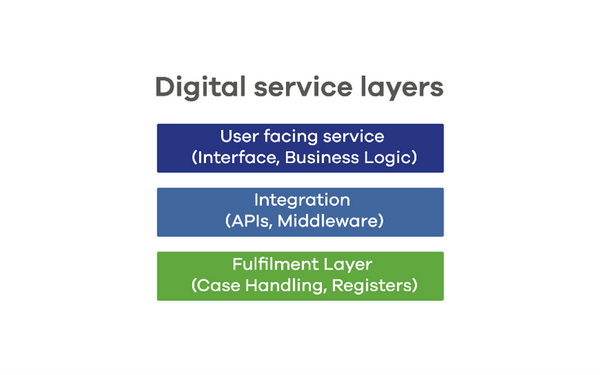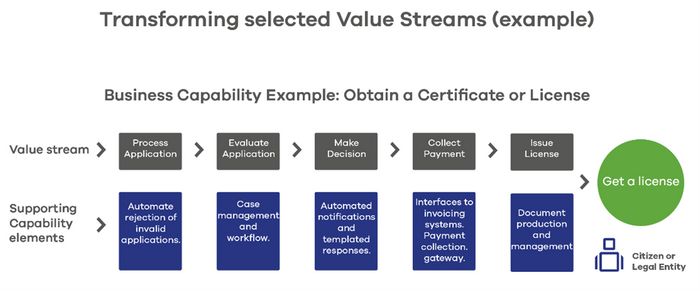Kainos: Digital transformation in a time of scarcity #techUKSmarterState
Whilst public sector budgets are shrinking, the list of government services that need digital transformation keeps growing. In the past, government digital initiatives have focused more on citizen-facing services. However, the much harder task has always been transforming the underpinning legacy systems and processes. According to a recent National Audit Office report, “simple online citizen transactions have been prioritised for transformation and more complicated services have been left behind.”
In response, the 2022-25 roadmap for digital and data published by the CDDO (Central Digital and Data Offices) quite rightly advocates the transformation of the whole service, including both the citizen facing element and the legacy processes and systems that fulfil these. Such an end-to-end view would address the following layers that typically constitute a government service:

The CDDO lists 75 key services for transformation across government departments, e.g., HMRC’s pay your Self-assessment Tax bill or the Department for Transport’s Apply for a Provisional Licence to name a couple. This is only a start. Each department will have its own growing list of smaller, nevertheless crucial, services sorely in need of transformation. And with limited budgets, this can be a significant challenge.
One answer is the use of shared technology services or reusable components, whether it is across government, like Gov.uk Notify or within a particular department, e.g., Single Sign-on (SSON). Many of these services tend to address universal, self-contained problems, e.g., the need to notify the user on completion of a transaction or the need to pay for a transaction. However, as departments evolve in digital maturity, other higher order repeating problem patterns begin to emerge.
Finding Higher Order Patterns
One example is the ubiquitous need for a permit or a license. Whether it is a permit to set up a childcare business or an authorisation to import farm goods from the EU (European Union), an individual or an organisation typically submits and pays for an application, which is then evaluated by an officer. If they are satisfied, they issue a permit or license, which authorises the applicant to carry out certain activities.

These vastly different scenarios above share some common characteristics. Hence, the question Organisations should ask is whether they would benefit from sharing not just technology components and services, but also human expertise, business processes and standards: effectively, a business capability.
The Organisational Culture
Capabilities do not build themselves. They require strategic thinking and conscious organisational design. In turn requires a strong organisational culture that promotes the certain key behaviours:
-
Consistency: Is there appetite and bandwidth in the organisation to look across silos and take a consistent approach to solving similar problems? Does it facilitate the evolution of standards, whilst allowing for differences? One common complaint is that stakeholders have their own project deadlines and hence consulting with other projects or building to a common standard is a luxury they cannot afford. The irony is that this results in further proliferation of context-specific solutions that have little scope for reuse.
-
Community: Does the organisation actively support the building of communities that can help diffuse ideas? Does it actively encourage its people to participate in them and give them the time to do so? The enthusiasm with which communities are initially set up wanes because of the lack of active facilitation and leadership support. As a result, they tend to be far less effective than intended.
-
Collaboration: Is the organisation adopting appropriate tools and practices for knowledge sharing and retention? For example, if a team has developed a reusable component, is this catalogued and described in an internal sharing site where other teams can search for and find it?
Start with the Leadership:
Any Public Sector organisation serious about digital transformation should invest time in exploring and describing the repeating problem patterns they encounter across the organisation. This will help identify potential areas where reusable capabilities can be built, which in turn can accelerate the transformation of its key services and save costs.
Making this work, however, requires the right organisational culture and long-term commitment, which in turn, requires the right leadership. So how ready is your organisation?

Rama Varma is Product Consultant at Kainos. Get in touch via LinkedIn.
From 11 – 15 September techUK is running our annual Building the Smarter State Week in the run-up to the ninth edition of our flagship public services conference, Building the Smarter State, on Wednesday 27 September. Book your tickets here.


